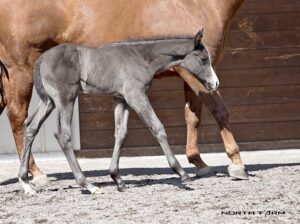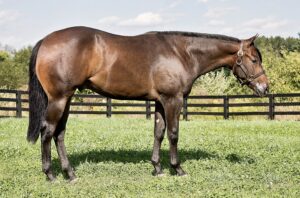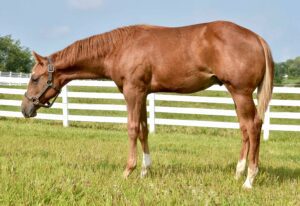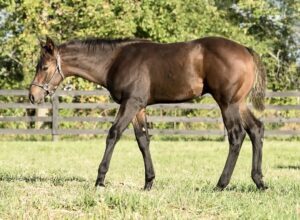It is often clear, once horses age, which individuals have potential to find success in the pleasure pen. Then, once an animal is a proven winner or point-earner, there is no longer a need to speculate.
However, these started or proven individuals come at a much higher price. This sticker shock often prices a large demographic of amateurs out of the market. For these people, finding a top pleasure contender requires a gamble by buying a weanling or yearling with the hope they develop into that proven animal years down the road.
We spoke with multiple World and Congress Champion breeder Debbi Trubee of North Farm to get her advice on what to look for in a young western pleasure prospect to hedge your bets for success down the road.
Form to Function – Neck
 Trubee sticks to the horseman’s adage that function follows form, which is to say “if they aren’t built right, they won’t move right.”
Trubee sticks to the horseman’s adage that function follows form, which is to say “if they aren’t built right, they won’t move right.”
One of the first things that catches Trubee’s well-trained eye is the animal’s neck. “If their neck comes out properly, they are going to naturally want to hang their neck out in front of them for the pleasure,” she explains.
So, what does Trubee want to see? She wants their neck “to come straight out of their withers and not tie in too deep down their chest.” Proportionately, their neck should “always be longer than the back – and the underline also needs to be longer than the back.”
Form to Function – Topline, Withers, and Shoulder
Naturally, when your eyes move from the head down the neck, you will next observe the animal’s back, withers, and shoulder.
 Trubee looks for an “upright” wither. This is her way of saying, “you want the build of the horse to be uphill as opposed to downhill.”
Trubee looks for an “upright” wither. This is her way of saying, “you want the build of the horse to be uphill as opposed to downhill.”
The function of this build in the pleasure is that the shoulder will be able to swing forward and stay out of the way of the animal so it can have free movement up front.
A downhill horse will mechanically collapse down on their front end in order to balance. The only way they can compensate for that is by lifting their front end high off the ground to get the front leg to reach.
Trubee adds, “A really well-made baby will never run far downhill. When a good baby is born, they are level. If they are running downhill and they don’t catch up, they will always be heavy on their front end.”
Trubee says that a downhill build tends to be a genetic trait. Therefore, researching the lines you are buying can help you anticipate whether your baby will stay fairly even as it grows with the hopes it will finish even or uphill.
“I also want to see a deep heart girth to support a good shoulder that isn’t too upright. While there is no ideal shoulder angle, you just want to see a shoulder that will allow the front leg to swing forward and have good range of motion. As a general rule, I like to see the shoulder and pastern angles match.”
Form to Function – Legs
Trubee wants to see an animal with “low hocks and low knees.” This is a common comment by top horsemen in the industry, but what exactly does that mean?
 Essentially, Trubee says that, “the cannon bones have to be shorter than the forearm for them to be flat in front. Hence, why we say we want to see ‘low knees.’”
Essentially, Trubee says that, “the cannon bones have to be shorter than the forearm for them to be flat in front. Hence, why we say we want to see ‘low knees.’”
Similarly, the hocks need to sit low to the ground in order for the animal to have good drive. Trubee finds that the hind end is often overlooked by buyers in favor of that straight front leg. However, the horse’s motor is in the back.
“If the hocks are set high on the hind leg, you will find that the back legs tend to pop up off the ground at the canter or lope.” In the pleasure pen, a horse with high hocks will not be physically capable of holding the ground and driving from behind – which will be a huge disadvantage at the lope.
Movement
Once you have found the ideal conformation, the movement should match.
Sometimes it can be hard to see a young horse move and envision how that will translate to the pleasure pen.
 “The biggest thing that amateurs tend to notice when the babies move is that their neck is down,” Trubee chuckles. “They get so mesmerized by looking at the topline, that they don’t look below the neck!”
“The biggest thing that amateurs tend to notice when the babies move is that their neck is down,” Trubee chuckles. “They get so mesmerized by looking at the topline, that they don’t look below the neck!”
She emphasizes, “My biggest advice to amateurs shopping for babies is to make sure you don’t discount a great-legged horse just because their head and neck are a little elevated in their foal video.”
Trubee finds that, “A truly great loper will raise up and lope off every time because it’s easy for them to do. When you see something pony trotting around that won’t lope off, it likely isn’t transitioning because it’s uncomfortable loping…and you don’t want that.”
Trubee recalls that many of the top pleasure horses she’s bred lope everywhere as a preferred means for covering ground. “I have some babies that I barely ever see trot because all they want to do is lope – it comes so easily for them. Those are the ones to keep an eye on.”
She ultimately looks for babies that move in–sync (where the reach of the front and hind match), with fluid, sweeping, but slow-legged movement.
Mind/Attitude
Finally, Trubee reminds readers that, although you cannot guarantee success on a baby (or even an older horse for that matter), one of the benefits of buying a prospect is that you can start them right from the beginning.
 Babies are somewhat of a blank slate and you can have a big impact through your handling on how they will behave and interact with people as a show horse. However, this is a make-or-break time in their lives.
Babies are somewhat of a blank slate and you can have a big impact through your handling on how they will behave and interact with people as a show horse. However, this is a make-or-break time in their lives.
“Amateurs tend to spoil their babies and I really want to caution them against that. You can tame wild. You can build confidence in a timid animal. And you can teach respect in a dominate animal. But I’ve found you can’t fix spoiled!”
Making sure that your baby respects your boundaries and personal space is critical to molding them into an ideal pleasure horse that is actually a pleasure to be around.
***
 Overall, Trubee is a firm believer in doing your homework. Research the lines that are having current success in the pleasure pen. Find an animal with the conformation that is set up for success in the western pleasure. And then make sure the movement matches the conformational potential. Once you have that, make sure to mold the mind of your young horse to be respectful and patient. Altogether, this will hedge your bets for success in the show pen.
Overall, Trubee is a firm believer in doing your homework. Research the lines that are having current success in the pleasure pen. Find an animal with the conformation that is set up for success in the western pleasure. And then make sure the movement matches the conformational potential. Once you have that, make sure to mold the mind of your young horse to be respectful and patient. Altogether, this will hedge your bets for success in the show pen.
Stay tuned for Parts 2 and 3 of our “Training the Eye” series where we will investigate what traits to look for in the ideal Hunter Under Saddle and All-Around prospects.









